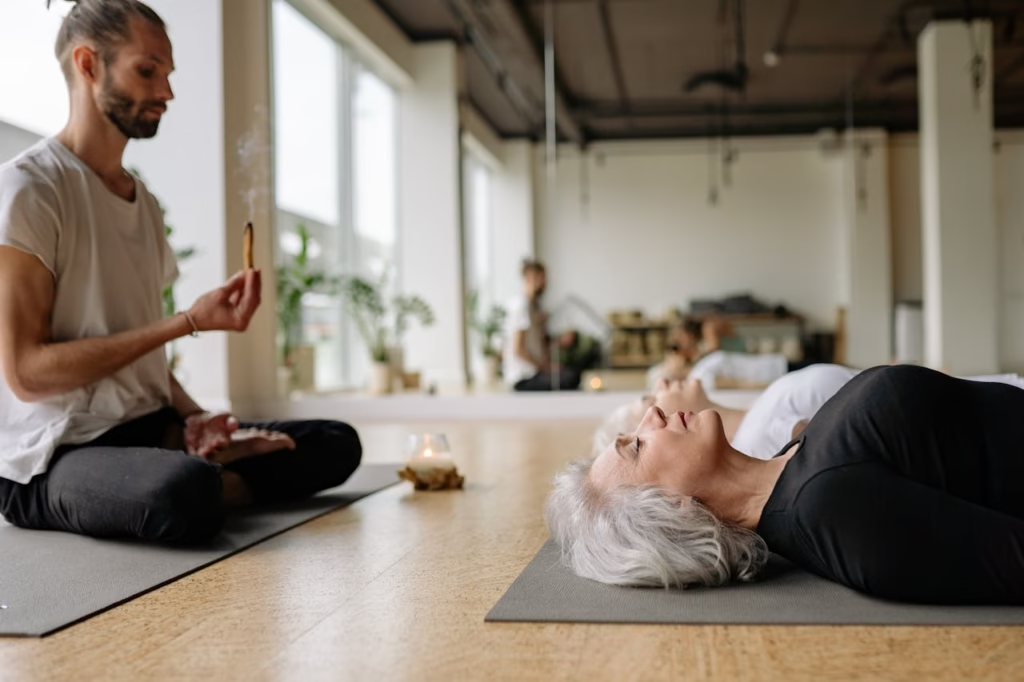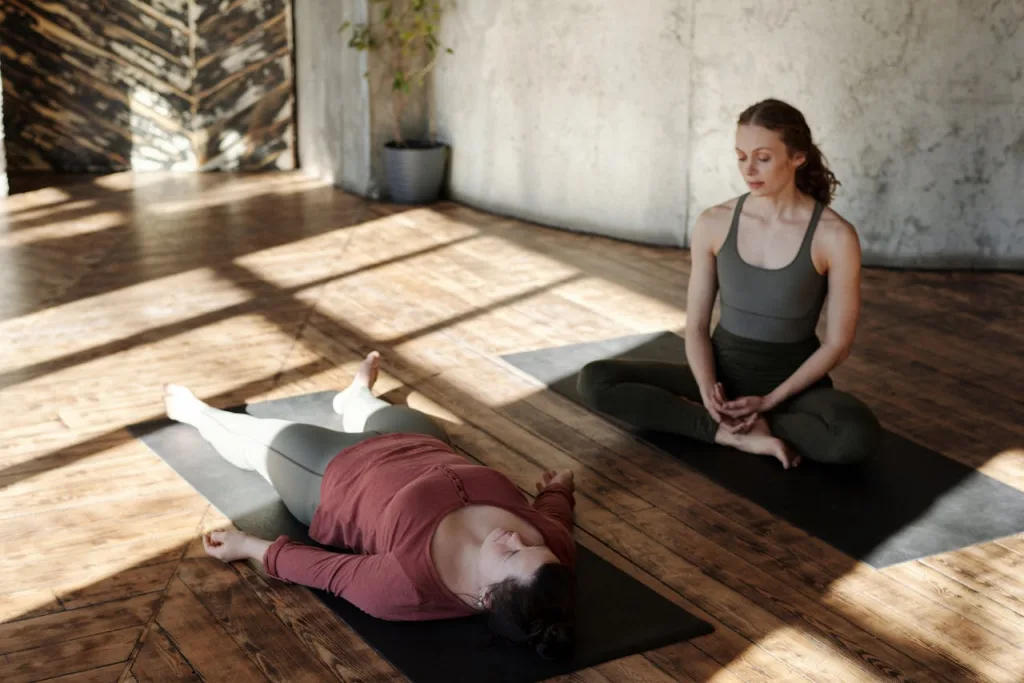I’m in an era of prioritizing both my body and mind. I focus not only on exercising, eating well, and improving sleep, but also on strengthening my mental, emotional, and spiritual health.
You can read every self-help book out there, but implementing everything you’ve learned can be incredibly difficult. I’ve found that the best way to grow is by attending retreats or visiting meditation centers and learning directly from people who have a deeper understanding of the spiritual world and can guide you. Being surrounded by others who are searching for similar answers makes it easier to stay focused and open.
I’ve just returned from a 3-day silent retreat and would love to share my experience, both to answer some common questions and maybe inspire you to try one yourself.
What Is a Silent Retreat?
A silent retreat is time dedicated to disconnecting from external noise and reconnecting with your inner self. Through silence, meditation, and nature, you’re given space to process emotions rather than suppress them.
Silent retreats are usually held in quiet, nature-filled settings to enhance relaxation. Meals are simple, often vegetarian or plant-based, to support digestion and detox.
While the format varies, some include yoga and breathwork , others focus solely on meditation, they all have core elements:
- No talking or communicating with others (even gestures or notes are often discouraged)
- No phones or electronic devices
- Minimal external distractions, including reading or journaling
All you need to do is be present and embrace the experience.
My 3-Day Silent Retreat Experience
I didn’t go in with huge expectations. I wanted a break from daily noise and responsibilities. I’d been feeling scattered and unfocused, and I thought this could help. I’m also preparing to attend a 10-day Vipassana retreat in the future, so this was a great first step. This was not my first meditation retreat, I have visited Pa Pae Meditation Retreat in Chiang Mai, Thailand. It only included one day of silence and was more focused on learning about Buddhism and meditation, so I wanted to challenge myself with more silence.
The retreat I chose included not only meditation but also yoga and breathwork, two practices I’m already somewhat familiar with. I’ve found that breathwork in particular helps me ease into deeper meditative states.
Like many others there, I worried I’d struggle with the silence or feel anxious about being offline. But to my surprise, I loved it. There was something freeing about not needing to make small talk or worry about how I came across to others. I felt deeply connected to the group, even without speaking. It was as if we understood each other’s energy without saying a word.
I also loved not having to make constant decisions about what to wear, what to eat, or what to do next. And honestly, not using a phone for three days felt incredibly refreshing.
The first day was the hardest, adjusting to the new environment and unfamiliar faces, not knowing if I could really stay silent. But by the second day, I felt more settled. By the third, I felt clearer, lighter, and more prepared to return to everyday life. Each day revealed something new and made me stronger and more aware.
I could feel an emotional release not only in my head but also in my body.
I can confidently say that spending time in a silent retreat is life-changing, and everyone should experience it.
One retreat won’t change your life completely, but it gives you tools to manage stress, regulate emotions, and build mental clarity over time. I left feeling more equipped to handle challenges and more committed to incorporating silence, meditation, and breathwork into my daily life.
How Long Should a Silent Retreat Be?
Retreats can last anywhere from two days to over ten. If you’re new to the practice, I recommend starting with a two or three-day retreat to ease in. Even a short experience can be transformative.
If you’ve done shorter retreats and want a deeper challenge, look into Vipassana meditation centers. These 10-day silent retreats are donation-based and offer a more intense experience. But be warned: they’re not easy. Many participants, including monks I’ve spoken with, say it’s the most challenging but rewarding thing they’ve ever done. Most people hit a breaking point around day four before pushing through to clarity.
Like preparing for a marathon, you should train your mind beforehand. I’m preparing now and hope to attend a 10-day Vipassana retreat in the next year.
Who Can Benefit from a Silent Retreat?
The short answer? Everyone.
We live in a world full of noise, distractions, and expectations. We often associate productivity with success, but our minds are not machines. They burn out. We all carry emotional baggage- unprocessed trauma, anger, jealousy, anxiety, fear, and many of us have habits we’d like to change, like doom-scrolling or emotional eating.
Silent retreats help us step away from that noise and give our minds time to rest, heal, and reset.
Getting the Most Out of Your Retreat
Follow the Rules
It might feel scary at first to be silent and disconnected, but most people quickly adjust and find it deeply calming and love the experience of silence. Respect the rules, not just for yourself, but for others sharing the experience with you.
Use Free Time Wisely
You’ll have periods of free time in between your practices and lectures. Rest if needed, but also try to deepen your practice. Meditation, reflection, or just walking in nature can enrich your experience.
Go In Without Expectations
Don’t expect to reach enlightenment or solve all your problems. Go in with an open heart and a willingness to learn.
Continue Your Practice
The retreat is just the beginning. Daily practice of 10 minute meditation in the morning or evening can bring lasting benefits. If not many people in your circle practice meditation, find a local or online community to stay connected and inspired.
Refresh Regularly
Mental and spiritual health requires consistency. Aim to refresh your practice every six months or so with another retreat or a dedicated weekend of silence.
How to Choose a Silent Retreat
Teachers:
Research their qualifications and reputation. Just because someone looks spiritual doesn’t mean they’ll be a good guide.
Accommodation:
Understand what’s offered. You may need to share a room. If you’re a light sleeper, bring earplugs or an eye mask. Comfort helps, but remember: this isn’t a luxury vacation.
Your Needs:
Be honest about your experience level. If you’re new to meditation, a beginner-friendly retreat with yoga or breathwork might be best. If you’re advanced, go deeper.
Cost:
Silent retreats range from budget-friendly to high-end. Pick one that fits your comfort level, but keep in mind that growth often happens outside your comfort zone.
Is a Silent Retreat Worth It?
In my personal experience, and from speaking with many others, it’s absolutely worth it.
The key is to go in open-minded, without expectations, and to trust the process. Silent retreats aren’t about perfection or performance. They’re about letting go of the outside world and tuning inwards.

FAQ
How do I prepare for a silent retreat?
If it’s beginner-friendly, not much prep is needed. Just go in open and be willing to trust the process.
What should I bring?
Organizers will usually give a list, but generally bring:
- Comfortable clothing
- Your own toiletries
- A reusable water bottle
- A watch (since you won’t use your phone)
What should I not bring?
- Junk food (if you bring snacks, make them healthy)
- Strong perfume (can distract others)
- Revealing or flashy clothing (aim for modest and comfortable)
Can I read or journal?
Some retreats allow it, but I recommend avoiding it. Let your mind be quiet, even if it’s uncomfortable. Some retreats may include reflective writing as part of the program.
Can I use my phone?
Usually not. In case of emergency, organizers typically provide a contact number you can share with loved ones.
Can I leave early?
Technically yes, but it’s rare. Most people stay through the end, especially on shorter retreats. On longer retreats, the desire to leave is part of the experience and part of your growth.
To summarize,
Whether you’re spiritually curious, emotionally drained, or just looking for space to breathe, silent retreats offer something valuable. The silence can be daunting at first, but on the other side, there’s clarity, peace, and transformation. If you can find some time in your busy schedule to experience it, you will understand how important “me time” is for our well-being, happiness, and productivity. When we are calmer and happier, we become better to others; therefore, silent retreats are not only good for you but also for the people around you.
Silvija Meilunaite, PN1-NC, CSMC, is a certified nutrition and menopause coaching specialist, and a writer in the nutrition and self-improvement field. She explores science-based approaches to holistic health and plant-based nutrition, with a strong focus on researching clean, non-toxic products that support long-term well-being.
- S. Meilunaitehttps://barefootbasil.com/author/silvootegmail-com/
- S. Meilunaitehttps://barefootbasil.com/author/silvootegmail-com/
- S. Meilunaitehttps://barefootbasil.com/author/silvootegmail-com/
- S. Meilunaitehttps://barefootbasil.com/author/silvootegmail-com/




